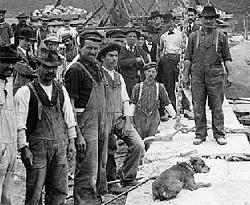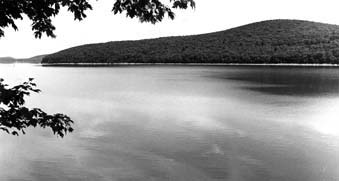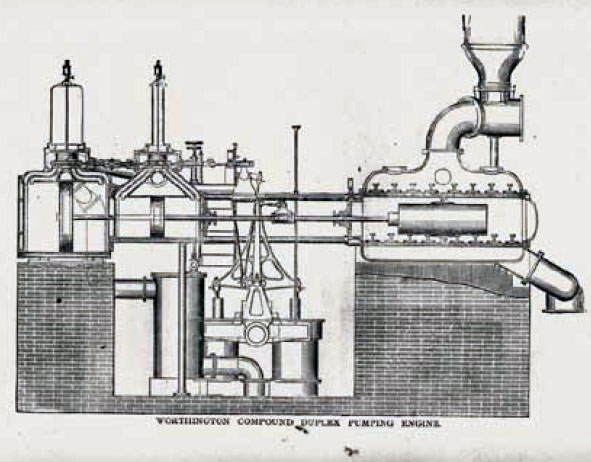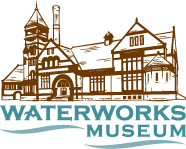Metropolitan Boston's Water System History
Massachusetts Water Resources Authority
Early Boston
Before
1795, Bostonians relied on local wells, rain barrels and a spring on the
Boston Common for their water.
Jamaica Pond: 1795-1848
In 1795, private water suppliers developed a delivery system, using wooden pipes made from tree trunks, to carry water from Jamaica Pond to Boston Proper.
In the 1840s, the City of Boston (pop. 50,000) was faced with water quality
and capacity problems. Jamaica Pond was lacking in capacity and becoming
increasingly polluted causing several epidemics. There were several disastrous
fires that could not be contained due to lack of delivery capacity.
A pure water source had to be found elsewhere.
Cochituate System: 1848-1951
In
1845, the Cochituate Water Board began construction of a transmission system.
A tributary of the Sudbury River was impounded, which created Lake Cochituate.
Cochituate, with its 17 square miles of watershed, 2 billion gallons of storage
and yield of 10 mgd, became the cornerstone of the Boston water system.
The Cochituate Aqueduct was completed to transport water to the Brookline
Reservoir from which pipelines were constructed to small distribution reservoirs
in all parts of the city. The first water from Lake Cochituate flowed into
the Frog Pond on Boston Common in 1848 at a dedication ceremony that drew
100,000 people.
One of the distribution reservoirs, the Beacon Hill Reservoir, was an elaborate facility constructed of granite. The reservoir was demolished to build the addition at the rear of the State House. South Boston High School was constructed at the site of another reservoir.
In 1870, the Mystic Lakes system in Winchester, Medford, and Arlington,
which had been developed by Charlestown, was added to the Boston system
when Charlestown was annexed. This lake system had a yield of 30 mgd from
its 28 square mile watershed. A portion of the original water mains to Charlestown
is still in service.
In 1951, the Cochituate Reservoir and Aqueduct were abandoned. At that
time, there were four aqueducts delivering water to the hub of the system
and the Cochituate system was unnecessary. The water had also declined
in quality and would have required treatment. A portion of the Boylston Street Mains has been rehabilitated and is still in service.
Cochituate summary
Source |
Yield |
Transmission Means |
Storage Destination |
Water Mains |
Comments |
| Lake Cochituate |
10 mgd |
Cochituate
Aqueduct |
Brookline
Reservoir |
Boylston
Street Mains |
Portion of the mains still in
service |
| Mystic Lakes |
30 mgd |
Mystic
Mains |
Tufts
University |
Mystic
Mains |
Portion of the mains still in
service |
The Sudbury Aqueduct and Chestnut Hill Reservoir: 1878
After
the Irish Potato Famine of 1843-45, Boston grew rapidly and by 1870, its
population exceeded 200,000 and consumed 17 mgd. Planners had not anticipated
this rapid growth; they thought that the Cochituate system would be adequate
for many years. The process of diverting water from a pure upland source
was repeated.
In 1878, the mainstream of the Sudbury River was diverted via the Sudbury Aqueduct to the Chestnut Hill Reservoir. Between 1875 and 1898, seven major reservoirs were constructed in the Upper Sudbury River Watershed. The Sudbury and Cochituate Aqueducts were designed to operate by gravity to fill the Chestnut Hill and Brookline Reservoirs, both of which are at Elevation 134. The Cochituate and Sudbury Aqueducts were interconnected at Chestnut Hill.
During this period, the following pressure zones were established:
- Boston Low
- Southern High
- Northern Low
- Northern High
Origin of the Boston Low Pressure Zone
A series of large diameter water mains were extended from the Chestnut Hill reservoir to parallel those from the Brookline Reservoir. The mains from these two reservoirs are still in service and constitute the Boston Low System.
By the turn of the century, the Boston Low System was transferred to the Weston Reservoir at the 200 foot elevation. A Chestnut Hill pumping station was needed to provide water to the southern high service areas.
Origin of the Southern High Pressure Zone
A high service pumping station was constructed at Chestnut Hill to lift water from the Chestnut Hill Reservoir to areas which could not be supplied by gravity. Water was pumped to the Waban Hill reservoir in Newton and the Fisher Hill reservoir in Brookline.
Origin of the Northern Low Pressure Zone
Charlestown was annexed to Boston during this era and its waterworks was integrated into the system. Charlestown's Mystic Lakes supply was conveyed by gravity to a pump station located near the intersection of the Alewife Brook and Mystic Valley Parkways and pumped to a reservoir which still exists (although no longer in use) beneath the quadrangle of Tufts University. A portion of the Mystic Supply Mains remains today as part of the Northern Low System.
A low service pumping station was constructed at the Chestnut Hill reservoir. Twin 48-inch diameter pipelines, the East and West Spot Pond Supply mains, were constructed from this pump station to the Mystic Main and continued to Spot Pond. After more than 100 years, these mains remain today as the principal supply to the Northern Low System.
Origin of the Northern High Pressure Zone
When Spot Pond was added to the system, it was raised 16 feet in elevation and the stream that formerly fed it was diverted around its perimeter. Spot Pond was converted into a distribution reservoir supplied only by pipelines. A pump station was constructed at Spot Pond to pump water to the Fells Reservoir which established the pressure gradient for the Northern High System.
Sudbury and Chestnut Hill Summary
Source |
Yield |
Transmission Means |
Storage Destination |
Water Mains |
| Sudbury River |
134' /
75 mgd |
Sudbury
Aqueduct |
Chestnut Hill
Reservoir |
East and West
Spot Pond
Supply Mains |
Wachusett Reservoir: 1897
 |
| Wachusett Dam work crew |
|
The
Boston metropolitan area continued to grow rapidly through the 1890s. Indoor
plumbing became commonplace. Planners had not foreseen this development
and supply had become inadequate.
At this time, the following water sources were considered: the Nashua River,
Lake Winnipesaukee, Sebago Lake, and the Merrimac River. Under the leadership
of Frederic Stearns, Chief Engineer of the Metropolitan Water Board, it
was decided that the new water source should be gravity-operated and not
require filtration.
In 1897, the Nashua River above the town of Clinton was impounded by the Wachusett Dam. Six and 1/2 square miles were flooded in the towns of Boylston, West Boylston, Clinton and Sterling. and its water conveyed by the Wachusett/Weston Aqueduct to Weston Reservoir and then by pipeline to the Chestnut Hill and Spot Pond Reservoirs. Work was completed in 1905 and the reservoir first filled in May 1908.
The Wachusett system was built to service the 29 municipalities within the 10 mile radius of the State House. At the time, the Wachusett Reservoir was the largest public water supply reservoir in the world.
Water from the Wachusett Aqueduct could be released into the reservoirs of the Sudbury River system for transport to Boston via the Sudbury Aqueduct. Water from the Wachusett Reservoir could also flow through the new Sudbury Reservoir to the Weston Aqueduct.
During this period, Chestnut Hill Reservoir was the hub of the system.
Wachusett System Summary
Source |
Yield |
Transmission Means |
Storage Destination |
Water Mains |
Wachusett
Reservoir |
395'/118 mgd*
65 billion gallons |
Wachusett
Aqueduct |
Weston
Reservoir |
Weston Aqueduct Supply Mains |
Future Plans
With rehabilitation of the Low Service system, three Weston Aqueduct Supply Mains (WASM) were cleaned and lined, and their old reduced-size gate valves were replaced with line-size butterfly valves. The rehabilitated mains will have the capacity to deliver 125 mgd from the new Loring Road Covered Storage Facility to the combined Boston and Northern Low Service areas.
 |
QUABBIN
RESERVOIR
At
412 billion gallons, the Quabbin is the largest man-made reservoir in
the world devoted solely to water supply. |
|
Quabbin Reservoir and Ware River Intake:
1926 -1946
Quabbin
Reservoir was Boston's fourth westward reach for a pure upland source of
water that could be delivered by gravity and not require filtration.
Construction of the Quabbin required impoundment of the Swift River and
the taking of the towns of Dana, Enfield, Greenwich, and Prescott.
In 1926, construction began on the Wachusett-Coldbrook Tunnel, which is
now the eastern section of the Quabbin Tunnel. Surplus flow in the Ware
River was diverted to the Wachusett Reservoir during eight high-water months
of the year and increased the safe yield by 40 mgd.
During the 1930s, the Wachusett-Coldbrook tunnel was extended to the Swift
River. It is a two-way tunnel: water flows west from the Ware River to the
Quabbin during the high-water months and then east from the Quabbin to Wachusett
at other times of the year.
Construction on the Quabbin Reservoir began in 1936. Filling commenced on
August 14, 1939 and was completed in 1946 when water first flowed over the
spillway. The Quabbin Reservoir was filled with water from the Swift River
and flood skimming from the Ware River during eight months of the year.
At the time, the 412 billion gallon reservoir was the largest man-made reservoir
in the world which was devoted solely to water supply.
Planners feel that the Quabbin will be sufficient to supply the metropolitan
area at least until the foreseeable future.
Origins of the Pressure Aqueduct System: 1936-1971
In
1936, the Legislature also approved the construction of the high service
Pressure Aqueduct System to deliver water to the Metropolitan area. Two
aqueducts would carry water from the Wachusett Reservoir to the new Norumbega
Reservoir in the Town of Weston. Downstream from Norumbega, the aqueduct
would split forming a loop around the metropolitan area which would terminate
at a greatly expanded Fells Reservoir in Stoneham. A branch would be constructed
off this loop to Quincy, terminating at a new Blue Hills Reservoir. The
Pressure Aqueduct could be operated at a uniform rate of flow as the distribution
reservoir storage would be sufficient to dampen out fluctuations in demand
during the day. Work began on schedule in 1939 and by the outbreak of
World War II in 1941, the Fells, Blue Hills and Norumbega Reservoirs had
been completed, and the Pressure Aqueduct had been built from the terminus
of the Wachusett Aqueduct to the terminus of the Weston Aqueduct. This
portion of the Pressure Aqueduct is the Hultman Aqueduct.
To pay for the new program, water rates were doubled from $50 to $100
per million gallons.
Quabbin System Summary
Source |
Yield |
Transmission Means |
Storage Destination |
| Quabbin Reservoir |
530'/155 mgd |
Quabbin Aqueduct |
Wachusett Reservoir |
Pressure Aqueducts: 1950-1978
After WWII, the remaining portions of the Pressure Aqueduct system came online as follows:
Portion of the
Pressure Aqueduct |
Description |
Date
Completed |
Comments |
Chicopee Valley
Aqueduct |
Quabbin Reservoir to Chicopee |
1950 |
CVA Aqueduct redundancy project (completed) |
| City Tunnel |
Hultman Aqueduct
Terminus to Chestnut Hill Reservoir |
1951 |
|
| City Tunnel Extension |
Chestnut Hill Reservoir part way to Fells Reservoir |
1961 |
|
| Cosgrove Tunnel |
Wachusett Reservoir to start of Hultman Aqueduct |
1965 |
|
| Dorchester Tunnel |
City Tunnel at Chestnut Hill Reservoir part way to Blue Hills Reservoir |
1978 |
Sudbury Aqueduct and Chestnut Hill
Reservoir taken offline |
As these sections of the Pressure Aqueduct have come online, the need for pumping has been reduced since more of the service area can be supplied by gravity. Older facilities which originally provided a level of redundancy to the new tunnels were eventually retired from use. More reliance was placed on the newer, partially completed system to the point where it is now relied upon to deliver 85 percent of metropolitan demand. Many of these expansions looked to use gravity for supplying water instead of costly pumping.
Origins of the Extra and Intermediate High Systems
Around 1951, several pump stations were constructed to take suction from WASM 3 and supply Extra or Intermediate High Service to the fast growing suburbs along Route 128.
By 1978, the Boston Low demand had been transferred to the Weston Aqueduct Supply Mains (Nos 1 and 2), supplemented by pressure reduction facilities from the City Tunnel. The Northern Low demand had been transferred to the Weston Aqueduct Supply Mains (Nos 3 and 4), supplemented after 1961 by pressure reduction from the City Tunnel Extension. The only demands remaining on the Sudbury Aqueduct were those of the Southern High and the Southern Extra High service areas, but these were, by this time, large enough to require its full capacity. Completion to the Dorchester Tunnel in 1978 allowed the demands of the southern systems to be removed from the Sudbury Aqueduct. However, because there is no redundancy for the Dorchester Tunnel, the facilities taken off line in 1978 must remain in stand-by status.
Although completion of the Dorchester Tunnel made it physically possible to remove the Sudbury Aqueduct/Chestnut Hill systems from active use, the primary reason for doing so was water quality. The Sudbury River did not meet quality standards without treatment and the uncovered Chestnut Hill reservoir, located in a highly urbanized area, further deteriorated in quality.
MWRA'S Integrated Water Supply Improvements: 1985 - TODAY
In 1985, the MWRA assumed responsibility for the delivery and distribution of water to 46 communities, primarily in the metropolitan Boston area. As of December 2020, The MWRA is responsible for the delivery and distribution of water to 53 communities, with the recent addition of the towns of Ashland and Burlington. The water system is managed as a partnership with the Department of Conservation and Recreation (DCR), which still maintains responsibility for managing the reservoir watersheds.
The MWRA developed the Integrated Water Supply/Quality Program to improve the reliability and quality of the water supply, and meet the stringent requirements of the Surface Water Treatment Rule promulgated by the federal EPA under the Safe Drinking Water Act. The Program is founded on the widely accepted multi-barrier approach to protecting the quality and safety of drinking water through watershed protection, proper water treatment and protection of treated water in covered tanks and clean pipes.
Historical Summary
Era and facility start-up dates |
Governing water authority |
Water Facilities |
Current facility status |
| Early Boston |
n/a |
Local wells, rain barrels, cisterns and springs |
n/a |
Early 19th Century
(1795-1845) |
n/a |
Jamaica Pond |
Off-line |
Cochituate System
(1845-1848) |
Cochituate Water Board
(active 1845-1875) |
Lake Cochituate
|
Off-line
|
| Cochituate Aqueduct |
Off-line |
| Brookline Reservoir |
Off-line |
| Boylston Street Mains |
In Service |
| Mystic Lake System |
Off-line |
Sudbury
and
Chestnut Hill
(1875-1878) |
Boston Water Board
(active 1875-1895) |
Framingham Reservoirs |
Off-line |
| Sudbury Aqueduct |
Emergency |
| Chestnut Hill Reservoir |
Emergency |
| Beacon Street Mains |
In service |
| Waban Hill Reservoir |
Emergency |
| Fisher Hill Reservoir |
Off-line |
Wachusett
(1895-1910) |
Metropolitan Water Supply Commission
(active 1926-1946) |
Wachusett Reservoir |
In service
|
| Sudbury Reservoir |
Emergency |
| Wachusett Aqueduct |
In service |
| Weston Aqueduct |
Emergency |
| Weston Reservoir |
Emergency |
| Spot Pond Reservoir |
Off-line |
| Fells Reservoir |
Off-line |
| Weston Aqueduct Supply Mains |
In service |
| Spot Pond Supply Mains |
In service |
| Several Pumping Stations |
In service |
Quabbin
(1926-1941) |
Metropolitan Water Supply Commission
(active 1926-1946) |
Ware River Intake |
In service |
| Wachusett-Coldbrook Tunnel |
In service |
| Quabbin Reservoir |
In service |
| Quabbin Tunnel |
In service |
| Hultman Aqueduct |
In service |
| Norumbega Reservoir |
Off-line |
| Blue Hills Reservoir |
Off-line |
| Fells Reservoir Expansion |
Off-line |
Pressure
Aqueducts
(1946-1978) |
Metropolitan District
Commission
(active 1946-1985) |
City Tunnel
|
In service |
| City Tunnel Extension |
In service |
| Cosgrove Tunnel |
In service |
| Dorchester Tunnel |
In service |
| Numerous pumping stations |
In service |
Integrated
Water System
Improvement
(1996-present)
|
MWRA
(active 1985-Present) |
Cosgrove Disinfection Facility |
Emergency |
| MetroWest Tunnel |
In service |
| John J. Carroll Water Treatment Plant |
In service |
| Blue Hills Covered Storage |
In service |
| Norumbega Covered Storage |
In service |
| Fells Covered Storage |
In service |
| Loring Rd. Covered Storage |
In service |
| Spot Pond Covered Storage |
In service |
Rehabilitation of Weston
Aqueduct and Spot Pond Supply Mains |
In service |
Back to top
Updated:
August 23, 2022 |




